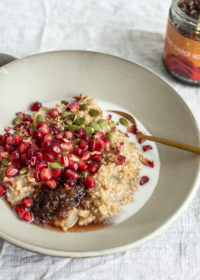Recipes: Raw Coconut Probiotic Yogurt
 Today is the last day of summer. I think we’re all lamenting how quickly it came and went this year. While it was over 100 degrees just the other day, the leaves are already turning yellow and falling off the trees one by one. It rained last night, bringing in a cool crisp breeze that is worthy of a big comfy sweater and an extra cup of tea today. And though I’m still dreaming of salty summer hair and open road adventures, my body is preparing for that winter hibernation mode. I’ve been craving roasted root vegetables and warming soups. My cooling summer smoothies seem to be the last thing my body wants for breakfast these days, even though I’m still fighting that reality a little bit (you know how much I adore my morning green smoothie ritual).
Today is the last day of summer. I think we’re all lamenting how quickly it came and went this year. While it was over 100 degrees just the other day, the leaves are already turning yellow and falling off the trees one by one. It rained last night, bringing in a cool crisp breeze that is worthy of a big comfy sweater and an extra cup of tea today. And though I’m still dreaming of salty summer hair and open road adventures, my body is preparing for that winter hibernation mode. I’ve been craving roasted root vegetables and warming soups. My cooling summer smoothies seem to be the last thing my body wants for breakfast these days, even though I’m still fighting that reality a little bit (you know how much I adore my morning green smoothie ritual).

To honor this request, I decided to shift my typical cold smoothie breakfasts to another raw favorite of mine – coconut probiotic yogurt. I love this dairy-free yogurt because it’s rich with healthy fats and probiotics, and is completely satiating, especially when topped with homegrown organic figs and raw honey from a sustainable co-op in Tulum, Mexico. And with the exception of hacking open a pile of coconuts, this recipe is pretty simple and straightforward.
Note: The key to opening a coconut is to have a sharp, heavy tool to open it. I have both a machete (thanks Kathleen!) and a Japanese cleaver. Invest in one of these, it’s worth it.
 There are two routes you can take with this yogurt: ready-t0-eat or the longer fermentation route. Both contain healthy gut promoting probiotics, but one is sweeter and one is a little more tart. If you’re a fan of the thicker, tarter Greek-style yogurts, then fermentation is the route for you. If you struggle with digesting foods and have slow elimination, then fermentation is the route for you. If you want a quick and healthy breakfast option, then this yogurt can be made and eaten without the fermentation process. However, I highly recommend making this recipe the evening before and taking the night to ferment it. Here’s why….
There are two routes you can take with this yogurt: ready-t0-eat or the longer fermentation route. Both contain healthy gut promoting probiotics, but one is sweeter and one is a little more tart. If you’re a fan of the thicker, tarter Greek-style yogurts, then fermentation is the route for you. If you struggle with digesting foods and have slow elimination, then fermentation is the route for you. If you want a quick and healthy breakfast option, then this yogurt can be made and eaten without the fermentation process. However, I highly recommend making this recipe the evening before and taking the night to ferment it. Here’s why….

Fermented foods – like kefir, yogurt, kimchi, and kraut – are the powerhouses of boosting digestion. These foods contain probiotic microbes that feed on the sugars naturally present in foods. As bacteria and yeast feed on the sugars around them, they release enzymes to break down large food particles. This means that fermented foods are predigested and full of enzymes. Predigested foods contain nutrients that are easy to absorb, meaning less work for your stomach and small intestine. Probiotic-rich foods also help synthesize nutrients like biotin, folate, and vitamin K2. These nutrients protect our cells from damage, nourish the brain, and support the skeletal system. Good bacteria actively fight harmful bacteria and produce specialized fats that control inflammation, reducing the body’s immune response to allergenic foods.

If you struggle with digestive issues, allergies, or a weak immune system, the boosting your probiotic intake through fermented foods can be especially healing for you. If you’re taking antibiotics or have taken antibiotics, taking a daily probiotic in addition to eating fermented foods can be very beneficial for repopulating your gut with the balance of good bacteria it needs.
 Now, if the thought of fermenting something at home makes you nervous – don’t be. It’s a fairly straight forward process that you can’t really go wrong with, and making this coconut yogurt is a great simple introduction to more complicated fermentation processes. Time is the trickiest part of fermentation. When making this yogurt, I like to set an alarm on my phone to remind me when 8 hours has passed. I’ve made this yogurt, placed it in my dehydrator to sit while fermenting, then completely forgotten about it for 36 hours…and the result was a pungent product I couldn’t stomach. I like to check it at the 8 hour mark because it’s just at that edge of being lightly sweet but a little tart. The longer you let it sit and ferment at room temperature, the more tart it will become. If you’re nervous about the flavor, check it after 6 hours. Determining the flavor and fermentation time is up to you and your taste buds. However, 14 hours seems to be a max time on fermentation for this yogurt specifically. After that, it has the potential to over-ferment and grow mold. To stop the fermentation process, give it a good stir and place it in an air-tight container in your fridge. The yogurt will stay good for up to a week after that.
Now, if the thought of fermenting something at home makes you nervous – don’t be. It’s a fairly straight forward process that you can’t really go wrong with, and making this coconut yogurt is a great simple introduction to more complicated fermentation processes. Time is the trickiest part of fermentation. When making this yogurt, I like to set an alarm on my phone to remind me when 8 hours has passed. I’ve made this yogurt, placed it in my dehydrator to sit while fermenting, then completely forgotten about it for 36 hours…and the result was a pungent product I couldn’t stomach. I like to check it at the 8 hour mark because it’s just at that edge of being lightly sweet but a little tart. The longer you let it sit and ferment at room temperature, the more tart it will become. If you’re nervous about the flavor, check it after 6 hours. Determining the flavor and fermentation time is up to you and your taste buds. However, 14 hours seems to be a max time on fermentation for this yogurt specifically. After that, it has the potential to over-ferment and grow mold. To stop the fermentation process, give it a good stir and place it in an air-tight container in your fridge. The yogurt will stay good for up to a week after that.

Another positive aspect of this dairy-free yogurt alternative, in addition to it’s fermented factor, is its special food combining benefits. Typical dairy-based yogurts combined with fruit – a breakfast staple for most – can cause poor digestion through improper food combining. When you eat fruit and dairy together, the dairy requires more enzymes to break down the heavier fats, while the fruit turns to sugar and sits on top of the heavier dairy products in the stomach. This combination can cause indigestion, gas, bloating and poor elimination. Fruit, in general, is best eaten alone and separate from other meals, and certain fruits combine better with other fruits. Here’s a helpful guide to the different classification of fruits (acid, sub-acid, sweet) for food combining purposes. So if you’re a lover of the fruit and yogurt combination, try this recipe instead, as fermented coconut yogurt rich in probiotics and enzymes combines better with fruits than pasteurized dairy products.
Fermenting this yogurt also takes out the strong coconut flavor, so it makes for a rich and creamy neutral base good for many flavor combinations. My boyfriend brought home fresh figs from his mother’s garden, so I opted for this fig and raw honey combination. I also love a good raw raspberry or apricot jam on my yogurt. The possibilities are endless here! If you come up with something wonderful, do share it with me!

COCONUT PROBIOTIC YOGURT
3 cups young thai coconut meat (about 3 coconuts)
½ cup fresh coconut water
3 tbsp coconut butter
1 tsp probiotic powder (about 5 capsules)
Using a heavy cleaver or machete, lay your coconut on its side and carefully cut the top off. Remove the top shell, then pour the coconut water into a jar. Once empty, turn the coconut right side up and quickly chop it in half. Using a spoon, scrape the meat out of the coconut, run under cool water to rinse off any pieces of the husk or shell. Repeat with remaining coconuts.
Add the coconut meat, water, and butter into a high-speed blender. Blend until creamy. Add the probiotics to the mix and blend again on low until well combined.
Transfer to a bowl. Cover with a porous cloth, like a cheesecloth, to allow the air to flow while keeping the bugs out. Place in a cool, dry area out of direct sunlight and allow to ferment for 8-12 hours. The longer the ferment time, the tarter the yogurt. If you want a sweeter, less fermented yogurt, start with 6 hours and taste from there. Before 14 hours, transfer yogurt to an airtight glass container and place in your fridge to stop the fermentation process and store for up to one week.
Makes about 4 cups
 [wpmenucart]
[wpmenucart] Recipes: Pomegranate, Pear & Rose Breakfast Porridge
Recipes: Pomegranate, Pear & Rose Breakfast Porridge  Recipes: Taos Blue Corn Muffins + Taos Retreat
Recipes: Taos Blue Corn Muffins + Taos Retreat  Recipes: Turmeric Ginger Oatmeal
Recipes: Turmeric Ginger Oatmeal 
Beautiful! You have a wonderful website I don’t have access to young coconuts where I live, but if I did I’d be making this ASAP. I’ll keep looking!
I don’t have access to young coconuts where I live, but if I did I’d be making this ASAP. I’ll keep looking!
Thank you! If coconuts are hard to come by where you’re at, you may look into the company “Exotic Superfoods”. They bottle fresh, non-pasteurized coconut water and package fresh coconut meat. They freeze and ship it to you. I’ve worked with their products before, they’re really high quality and the next best thing to cracking open the coconut yourself. Check it out!
http://www.exoticsuperfoods.com
Dear Claire, what probiotic powder would you recommend? Love your blog and these recipes!! Oh, do I need to use young coconuts? Love, Pauli
Hi Pauli! I use the probiotic powder from the capsules I take as my daily supplement. The brand I’m using right now is “Jarrow Ideal Bowel Support”. As for the coconuts, yes young coconut meat is best. The brown mature coconut meat is too hard to use. If you can’t find young coconuts at your local markets, then you might try the link I mentioned below for ordering the meat or water specifically from Exotic Superfoods.
I really do need to get onto trying to make my own coconut yoghurt! Yours looks amazing
Thank you! It’s so simple to make, and you can never go wrong with having a big jar of it in your fridge. We’ve been putting it on top of baked apples lately in place of ice cream…and we’re kind of in love.
PS – Your blog is lovely!
Hi Claire, I’d love to make this recipe but I haven’t been able to find any coconut butter. Is there anything I can substitute it with? Is brazil nut butter ok? Or can I just leave it out? Thanks Emily
Emily
Hi Emily! This recipe can be made without the coconut butter, just cut back on the coconut water to make the consistency thicker.
Oh I can’t wait to try this!!! I love your blog. So beautiful!! Those figs are gorgeous.
Thank you Anna! I’m eager for fig season to roll around this year, always my favorite time of year
[…] compote to layer on top. If ice cream isn’t your thing, I also enjoy this compote on top of coconut yogurt. And I imagine it would go quite well on a morning porridge, too! I hope you enjoy this recipe and […]
Can you make this using canned coconut milk?
Great question! You can use canned coconut milk, but the process of making the yogurt is very different than this recipe. It requires agar agar or tapioca starch as a thickening agent to get the consistency of yogurt and heating it on a stove top to fully incorporate before fermenting. If you can’t get fresh coconuts at a local grocery or asian market, I’ve found ordering the meat/water from Exotic Superfoods is another option if you’re wanting to explore this as a raw coconut yogurt recipe.